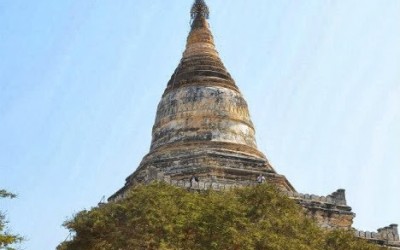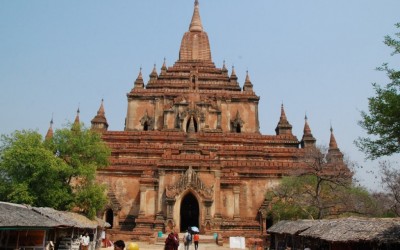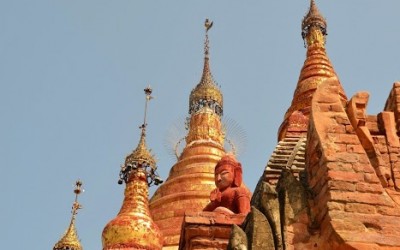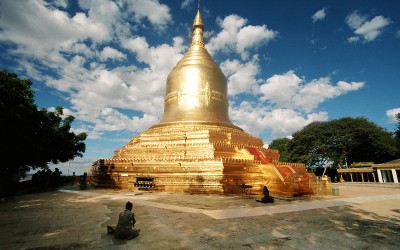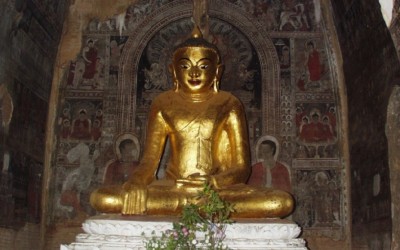Gawdaw Palin
Gawdawpalin is a large two-storied structure with a sikhara top. It resembles other large structures such as Thatbyinnyu, Sulamani, Htilominlo, etc. The temple is located in the southwest… Read More
Loka-hteik-pan
Built in the reign of Kyanzittha’s successor, Sithu I, “Loka-hteik-pan” (also known as Lawka Hteik Pan) means “adorning the top of the world”. This temple has a special exemplary status in Burmese Sacred art…Read more
Lokananda
This 11th-century stupa in the southwest of Bagan Myo Thit (New Bagan town) lies on the river bank, like Bu Hpaya. There is, however, no jetty, modern cement stairways led from the beach and the road to the shrine. The bell-shaped stupa stands on octagonal and two 16-sided terraces. Two inscriptions can be found in the shed, and these date to the 13th century…Read more
Dhammayazika
Dhammayazika is a pentagonal stupa which dates to the 12th century. The date of 1197-1198 for the temple is derived from a broken stone inscription, now in the hall on the east side. The stupa sits on successive terraces, which contain green glazed plaques depicting scenes from the Jataka tales…Read more
Dhammayangyi
Dhammayangyi can be considered the mammoth temple of Bagan with its huge walled enclosure occupying a large swath of land. The top of the temple was ruined during the 1975 earthquake, but it was never restored, adding to the charm of the structure…Read more
Sulamani
The Sulamani temple dates to 1183 based on a stone inscription found in the structure’s northern entrance hall. This two-storied temple resembles other enormous temples, such as Thatbyinnyu, Gawdawpalin, and Htilominlo,etc. The temple similarly sits within a walled enclosure or compound…Read more
Shwehsandaw
Dating to c. 11th century, the Shwehsandaw is associated with King Anawrahta of Bagan (1044-77). The shrine purportedly contains a sacred hair relic of the Buddha. The narrow bell-shaped stupa stands on a series of four terraces, which are white-washed. A number of unglazed plaques can be found…Read more
Thatbyinnyu
This is the tallest building in Bagan; the temple also differs from other structures in Bagan in another area: the main Buddha sits within the upper-story shrine. Thatbyinnyu is dated to the 12th century, and shares much in common with other massive temples, such as Sulamani, Gawdawpalin, and Htilominlo, etc…Read more
Ananda Hpaya
In Bagan, there is a popular saying which links three religious structures. In Bagan, the most beautiful temple is Ananda, the tallest is Thatbyinnyu, and the largest is Dhammayangyi. Ananda dates to the 11th and 12th centuries, and is believed to have been constructed during the reign of King Kyanzittha (1084-1113)…Read more
Bu Hpaya
Bu Hpaya is a stupa located on the river bank on the north part of Bagan old city wall. The structure’s location suggests that it could have been closely associated with a jetty on the river in ancient times. The shape and style of the stupa have led some to suggest that the structure could be dated to the 9th century or the Pyu period…Read more
Shwezigon
The Shwezigon is a stupa which dates to the 11th and 12th centuries. It is considered one of Burma’s most revered shrines. This stupa represents one of four Buddha’s tooth relic shrines associated with King Anawrahta (1044-77) of Bagan, a monarch credited with the establishment of orthodox Buddhism in Bagan…Read more
Htilominlo
This large two-storied temple was likely built during the late 12th or early 13th century. In terms of layout, it resembles the layouts of Gawdawpalin and Sulamani. The temple sits within a walled enclosure. Much of the beautiful stucco remains on the exterior of the structure. There are also two-colored glazed plaques…Read more
Lin Pya Gu Hpaya
textextextexttextextextexttextextextexttextextextexttextextextexttextextextext…Read more
Abeyadana Hpaya
textexttextexttextexttextexttextexttextexttextexttextexttextexttextexttextexttextexttextexttextextv…Read more
Yadanar Zedi Hsin Pya Gu
Texttexttexttexttexttexttexttexttexttexttexttexttexttexttexttextv…Read more
Myebontha Hpaya Hla
Texttexttexttexttexttexttexttexttexttexttexttexttexttexttexttexttexttexttexttexttext…Read more
Shin Ma Hti
Texttexttexttexttexttexttexttexttexttexttexttexttexttexttexttexttexttext…Read more
Tha Kya Muni Hpaya
TextTextTextTextTextTextTextTextTextTextTextText…Read more
Htitaw Kyauksa gu
Textexttexttexttexttexttexttexttexttexttexttexttexttexttexttext…Read more
List of Temples
Thatbyinnyu
This is the tallest building in Bagan; the temple also differs from other structures in Bagan in another area: the main Buddha sits within the upper-story shrine. Thatbyinnyu is dated to the 12th century, and shares much in common with other massive temples, such as...
Shwehsandaw
Dating to c. 11th century, the Shwehsandaw is associated with King Anawrahta of Bagan (1044-77). The shrine purportedly contains a sacred hair relic of the Buddha. The narrow bell-shaped stupa stands on a series of four terraces, which are white-washed. A number of...
Sulamani
The Sulamani temple dates to 1183 based on a stone inscription found in the structure’s northern entrance hall. This two-storied temple resembles other enormous temples, such as Thatbyinnyu, Gawdawpalin, and Htilominlo,etc. The temple similarly sits within a walled...
Dhammayangyi
Dhammayangyi can be considered the mammoth temple of Bagan with its huge walled enclosure occupying a large swath of land. The top of the temple was ruined during the 1975 earthquake, but it was never restored, adding to the charm of the structure. The temple leads...
Dhammayazika
Dhammayazika is a pentagonal stupa which dates to the 12th century. The date of 1197-1198 for the temple is derived from a broken stone inscription, now in the hall on the east side. The stupa sits on successive terraces, which contain green glazed plaques depicting...
Lokananda
This 11th-century stupa in the southwest of Bagan Myo Thit (New Bagan town) lies on the river bank, like Bu Hpaya. There is, however, no jetty, modern cement stairways led from the beach and the road to the shrine. The bell-shaped stupa stands on octagonal and two...
Loka-Hteik-Pan
Built in the reign of Kyanzittha’s successor, Sithu I, “Loka-hteik-pan” (also known as Lawka Hteik Pan) means “adorning the top of the world”. This temple has a special exemplary status in Burmese Sacred art. The painters of the early twelfth-century, closely followed...


